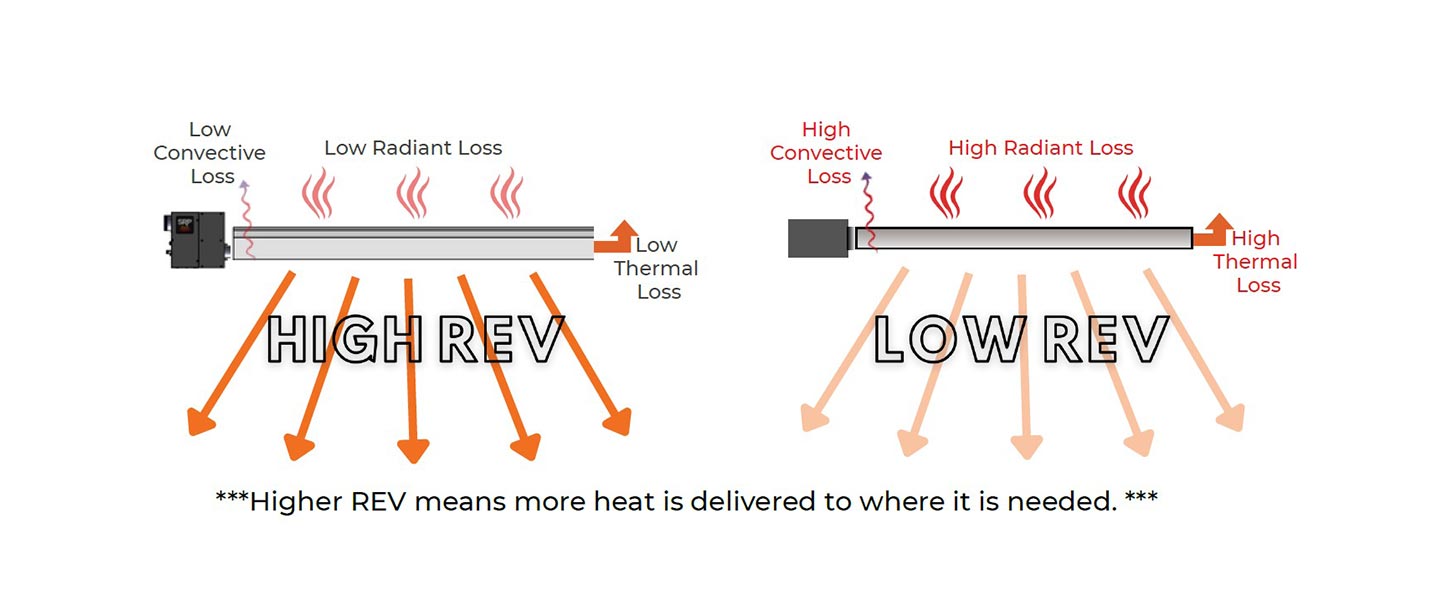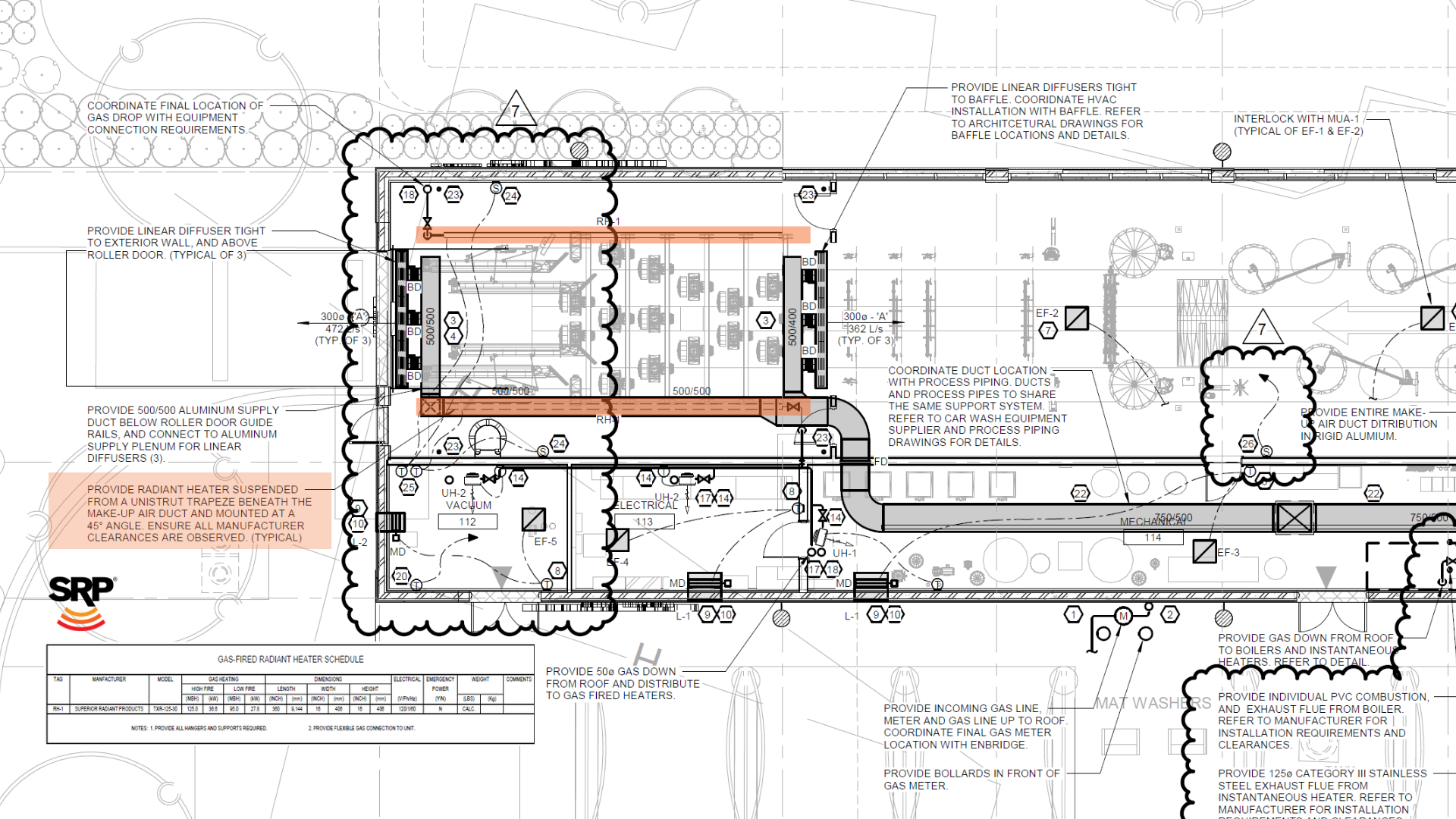OVERVIEW
The ANSI/AHRI Standard 1330-2024 (SI) establishes an essential framework for objectively measuring and rating the radiant performance of gas-fired infrared heaters. As the latest industry benchmark, AHRI 1330-2024 introduces the Radiant Emission Value (REV), offering a quantifiable performance metric crucial for accurate specification and comparison of radiant heating equipment.
UNDERSTANDING RADIANT EMISSION VALUE (REV)
The performance of gas-fired radiant heaters and systems is measured by thermal efficiency and radiant efficiency. The Radiant Emission Value (REV) represents emission efficiency, i.e. the proportion of the heater’s energy input that is delivered as usable radiant heat to the occupied space. Emission efficiency greater than 1 does not imply that the heater produces more energy than the fuel input; rather, it indicates that the radiant heater provides more useful heat to the occupied space compared to the equivalent fuel input of a reference warm-air heating system. The REV replaces older metrics, providing clear, consistent, and replicable measures to enhance product comparisons and selection accuracy. The REV connects the radiant efficiency determined under laboratory conditions with the corresponding emission efficiency achieved in real-world operation.
Key components of AHRI 1330-2024:
- Standardized Testing Protocols: Ensures all manufacturers measure performance consistently.
- Clear Performance Metrics: Facilitates precise product comparisons based on real-world efficiency.
- Mandatory Labeling and Documentation: Enhances transparency, informing customers accurately of product capabilities.
NECB 2020 ADOPTION OF MINIMUM PERFORMANCE CRITERIA
The National Energy Code of Canada for Buildings (NECB) 2020 has adopted minimum performance criteria for gas-fired infrared heaters. Specifically, NECB 2020 prescribes minimum Net Radiant Efficiency (NRE) values measured according to European standards:
- Gas-fired infrared heaters, high-intensity: DIN EN 419 — NRE ≥ 55%
- Gas-fired infrared heaters, tubular and low-intensity: DIN EN 416 — NRE ≥ 45%
These values were based on testing protocols aligned with AHRI 1330 methodology, and uses NRE as the benchmark efficiency measure. The current AHRI 1330-2024 standard has since been updated to use Radiant Emission Value (REV) as the principal performance metric.
BRIDGING NECB CRITERIA WITH AHRI 1330-2024
While NECB 2020 continues to reference NRE for compliance purposes, the AHRI 1330-2024 standard provides a more advanced and precise measurement methodology (REV). For manufacturers and engineers:
- AHRI 1330-2024 testing results can be mapped against NECB NRE thresholds, ensuring compliance for high-intensity and low-intensity products.
- REV offers greater precision for design, performance modeling, and future regulatory alignment.
- As NECB and other codes evolve, REV-based criteria are expected to gradually replace NRE, bringing North American standards in line with global testing best practices.
IMPORTANCE FOR SPECIFICATION AND COMPLIANCE
AHRI 1330-2024 certification is crucial, even though current North American energy codes (DOE, ASHRAE 90.1, IECC, and NECB) do not yet mandate REV criteria specifically. Specifying products tested under AHRI 1330 provides:
- Confidence in documented efficiency and reliability.
- Clear evidence supporting compliance with NECB 2020’s minimum NRE values for tubular and high-intensity heaters.
- Future-proof alignment with evolving performance-based codes and incentive programs.
PRACTICAL APPLICATION IN BUILDING DESIGN AND ENGINEERING
Leveraging AHRI 1330-certified heaters allow engineers and architects to:
- Precisely model energy consumption and radiant comfort in simulation software.
- Select products confidently based on emission efficiency achieved in real-world operation.
- Demonstrate measurable compliance with both prescriptive and performance compliance paths.
STRATEGIC ADVANTAGES FOR WHOLESALERS AND REPRESENTATIVES
For distributors and sales representatives, products tested to AHRI 1330-2024:
- Clearly differentiate offerings with objective, standardized performance metrics.
- Strengthen technical credibility with engineers and code officials by referencing both current NECB minimum NRE thresholds and REV test results.
- Highlight code compliance and future-ready performance in sales presentations and specifications.
CONCLUSION AND RECOMMENDATIONS
Although NECB 2020 currently mandates minimum radiant efficiency values (NRE ≥ 55% for high-intensity; NRE ≥ 45% for tubular/low-intensity), ANSI/AHRI 1330- 2024 introduces the more advanced Radiant Emission Value (REV) metric. Products tested under AHRI 1330-2024 not only demonstrate compliance with NECB requirements but also establish credibility and future readiness as codes evolve.
RECOMMENDED ACTIONS
- Feature both NRE compliance (for NECB 2020) and REV test results (per AHRI 1330-2024) in technical documentation.
- Train technical sales teams to articulate the difference between NRE and REV, ensuring clarity for specifiers and engineers.
- Advocate for REV adoption in future energy codes, positioning products ahead of regulatory transitions.



